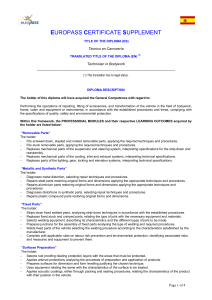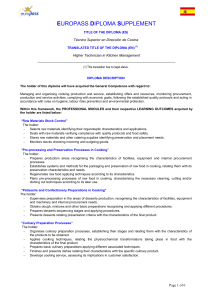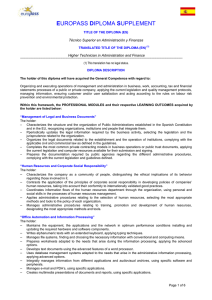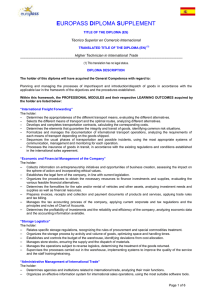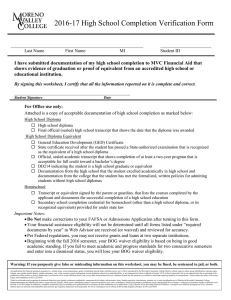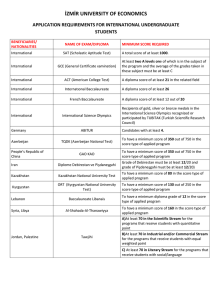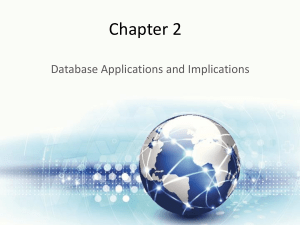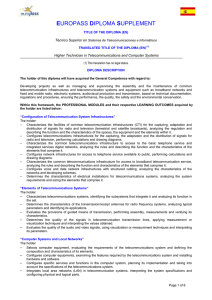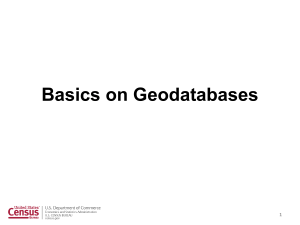Multi-platform Applications Development
Anuncio
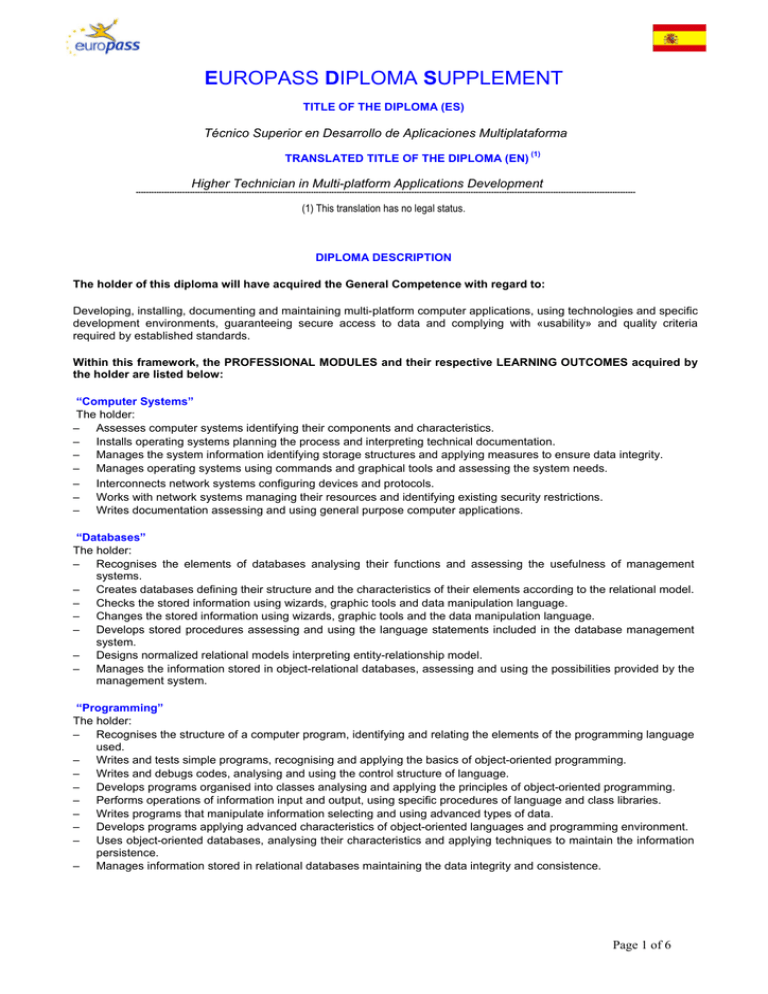
EUROPASS DIPLOMA SUPPLEMENT TITLE OF THE DIPLOMA (ES) Técnico Superior en Desarrollo de Aplicaciones Multiplataforma TRANSLATED TITLE OF THE DIPLOMA (EN) (1) Higher Technician in Multi-platform Applications Development -------------------------------------------------------------------------------------------------------------------------------------------------------------------------------------------------- (1) This translation has no legal status. DIPLOMA DESCRIPTION The holder of this diploma will have acquired the General Competence with regard to: Developing, installing, documenting and maintaining multi-platform computer applications, using technologies and specific development environments, guaranteeing secure access to data and complying with «usability» and quality criteria required by established standards. Within this framework, the PROFESSIONAL MODULES and their respective LEARNING OUTCOMES acquired by the holder are listed below: “Computer Systems” The holder: – Assesses computer systems identifying their components and characteristics. – Installs operating systems planning the process and interpreting technical documentation. – Manages the system information identifying storage structures and applying measures to ensure data integrity. – Manages operating systems using commands and graphical tools and assessing the system needs. – Interconnects network systems configuring devices and protocols. – Works with network systems managing their resources and identifying existing security restrictions. – Writes documentation assessing and using general purpose computer applications. “Databases” The holder: – Recognises the elements of databases analysing their functions and assessing the usefulness of management systems. – Creates databases defining their structure and the characteristics of their elements according to the relational model. – Checks the stored information using wizards, graphic tools and data manipulation language. – Changes the stored information using wizards, graphic tools and the data manipulation language. – Develops stored procedures assessing and using the language statements included in the database management system. – Designs normalized relational models interpreting entity-relationship model. – Manages the information stored in object-relational databases, assessing and using the possibilities provided by the management system. “Programming” The holder: – Recognises the structure of a computer program, identifying and relating the elements of the programming language used. – Writes and tests simple programs, recognising and applying the basics of object-oriented programming. – Writes and debugs codes, analysing and using the control structure of language. – Develops programs organised into classes analysing and applying the principles of object-oriented programming. – Performs operations of information input and output, using specific procedures of language and class libraries. – Writes programs that manipulate information selecting and using advanced types of data. – Develops programs applying advanced characteristics of object-oriented languages and programming environment. – Uses object-oriented databases, analysing their characteristics and applying techniques to maintain the information persistence. – Manages information stored in relational databases maintaining the data integrity and consistence. Page 1 of 6 “Markup Language and Information Management Systems” The holder: – Recognises the characteristics of the markup language analysing and interpreting code fragments. – Uses markup languages for the transmission of information through the web analysing the structure of documents and identifying their elements. – Creates content channels analysing and using syndication technologies. – Establishes validation mechanisms for XML documents using methods to define their syntax and structure. – Carries out conversions of XML documents using processing techniques and tools. – Manages information in XML format analysing and using storage technologies and query languages. – Works with business information management systems carrying out tasks of import, integration, assurance and extraction of information. “Development Environments” The holder: – Identifies the elements and tools that intervene in the development of a computer program, analysing their features and phases that must be followed until final release. – Assesses integrated development environments analysing their characteristics in order to edit source code and generate executable files. – Verifies that programs are operative designing and carrying out tests. – Optimises codes using available tools in the development environment. – Generates class diagrams assessing their importance in the development of applications and using available tools in the environment. – Generates behaviour diagrams assessing their importance in the development of applications and using available tools in the environment. “Data Access” The holder: – Develops applications that manage information stored in files identifying their application field and using specific classes. – Develops applications that manage information stored in relational databases identifying and using connection mechanisms. – Manages data persistence identifying object-relational mapping (ORM) tools and developing applications that make use of them. – Develops applications that manage information stored in object-relational and object-oriented databases assessing their characteristics and using access mechanisms. – Develops applications that manage information stored in native XML databases assessing and using specific classes. – Programs components to access data identifying the characteristics a device must have and using development tools. “Interface Development” The holder: – Generates graphical user interfaces through visual editors using their functionalities and adapting the generated code. – Generates XML-based graphical user interfaces using specific tools and adapting the generated XML document. – Creates visual components assessing and using specific tools. – Designs graphical interfaces identifying and applying usability criteria. – Writes reports assessing and using graphical tools. – Documents applications selecting and using specific tools. – Prepares applications for distribution assessing and using specific tools. – Assesses how applications work designing and carrying out tests. “Multimedia Programming and Mobile Devices” The holder: – Applies development technologies for mobile devices assessing their features and capacities. – Develops applications for mobile devices analysing and using specific technologies and libraries. – Develops programs that integrate multimedia contents analysing and using specific technologies and libraries. – Selects and tests game engines analysing the 2D and 3D game architecture. – Develops simple 2D and 3D games using game engines. Page 2 of 6 “Services and Processes Programming” The holder: – Develops applications made up of different processes recognising and applying principles of parallel programming. – Develops applications made up of different threads of execution analysing and applying specific libraries of programming language. – Programs network communications mechanisms using sockets and analysing the execution scenarios. – Develops applications that provide network services, using class libraries and applying efficiency and availability criteria. – Protects applications and data defining and applying security criteria to access, store and transmit information. “Business Management Systems” The holder: – Identifies enterprise resource planning and customer relationship management (ERP-CRM) systems identifying their characteristics and verifying the configuration of the computer system. – Implements ERP-CRM systems interpreting technical documentation and identifying the different options and modules. – Performs management and information query operations following design specifications and using the tools provided by the ERP-CRM systems. – Adapts ERP-CRM systems identifying requirements of a specific business and using the tools they provide. – Develops components for an ERP-CRM system analysing and using the incorporated programming language. “Project on Multi-platform Applications Development” The holder: – Identifies the needs of the production sector, relating them with the standard projects that may satisfy them. – Designs projects related to the competences described in the diploma, including and developing their constituting stages. – Plans the project implementation, determining the intervention plan and associated documentation. – Defines the procedures for the monitoring and control of the project implementation, justifying the selection of variables and instruments used. “Professional Training and Guidance” The holder: – Selects job opportunities, identifying the different possibilities of getting back into the world of work, and the alternatives of lifelong learning. – Applies teamwork strategies, assessing their effectiveness and efficiency on the achievement of the company’s goals. – Exercises rights and complies with the duties derived from labour relationships, recognising them in the different job contracts. – Determines the protection action of the Spanish Health Service in view of the different covered eventualities, identifying the different types of assistance. – Assesses risks derived from his/her activity, analysing job conditions and risk factors present in his/her labour setting. – Participates in the development of a risk prevention plan in a small enterprise, identifying the responsibilities of all agents involved. – Applies protection and prevention measures, analysing risk situations in the labour setting of the Higher Technician in Multi-platform Applications Development. “Business and Entrepreneurial Initiative” The holder: – Recognises skills related to entrepreneurial initiative, analysing the requirements derived from job positions and business activities. – Defines the opportunity of creating a small enterprise, assessing the impact on the performance setting and incorporating ethic values. – Carries out the activities for the setting-up and implementation of a company, choosing the legal structure and identifying the associated legal obligations. – Carries out basic administrative and financial management activities of an SME, identifying the main accounting and tax obligations and filling in documentation. Page 3 of 6 “On the Job Training” The holder: – Selects job opportunities, identifying the different possibilities of getting back into the world of work, and the alternatives of lifelong learning. – Applies labour and ethic habits in his/her professional activity according to the characteristics of the job position and the procedures established by the company. – Organises work to be carried out, identifying allocated tasks through project planning and interpreting specific documentation. – Manages and uses computer systems and development environments, assessing their requirements and characteristics according to purpose of use. – Participates in the development of data access applications planning the database structure and assessing the reach and repercussion of transactions. – Intervenes in the development of games, multimedia applications and mobile devices applications using specific tools and languages and complying with the established requirements and specifications. – Collaborates in the development and test of multiplatform applications, from the interface to the process and services programming, including packing and distribution, as well as associated help and documentation. – Participates in the process of deployment and adaptation of resource management systems and enterprise planning (ERP-CRM) analysing their characteristics and assessing changes. RANGE OF OCCUPATIONS ACCESSIBLE TO THE HOLDER OF THE DIPLOMA The Higher Technician in Multi-platform Applications Development works in public or private companies, either as a selfemployed or employee, carrying out his/her tasks in the area of multi-platform computer applications development in different fields: business management, relationships with customers, education, leisure time, mobile devices and entertainment, among others; applications developed and deployed in intranet, extranet and internet environments; deployment and adaptation of enterprise resource planning and customer relationship management. The most relevant occupations or jobs are the following: Developing computer applications for business management Developing general purpose applications Developing applications in the field of entertainment and mobile computing AWARD, ACCREDITATION AND LEVEL OF THE DIPLOMA Name of the body awarding the diploma on behalf of the King of Spain: Spanish Ministry of Education or the different Autonomous Communities according to their areas of competence. The title has academic and professional validity throughout Spain. Official duration of the education/ training leading to the diploma: 2000 hours. Level of the diploma (national or international) NATIONAL: Non-University Higher Education INTERNATIONAL: Level 5 of the International Standard Classification of Education (ISCED5). Level _______ of the European Qualifications Framework (EQF__). Entry requirements: Holding the Certificate in Post-Compulsory Secondary Education (Bachillerato) or holding the corresponding access test. Access to next level of education/training: This diploma provides access to University studies. Legal basis. Basic regulation according to which the diploma is established: Minimum teaching requirements established by the State: Royal Decree 450/2010 of 16 April, according to which the diploma of Higher Technician in Multi-platform Applications Development and its corresponding minimum teaching requirements are established. Explanatory note: This document is designed to provide additional information about the specified diploma and does not have any legal status in itself. Page 4 of 6 COURSE STRUCTURE OF THE OFFICIALLY RECOGNISED DIPLOMA PROFESSIONAL MODULES IN THE DIPLOMA ROYAL DECREE CREDITS ECTS Computer Systems. 10 Databases. 11 Programming. 14 Markup Language and Information Management Systems. 7 Development Environments. 6 Data Access. 9 Interface Development. 9 Multimedia Programming and Mobile Devices. 7 Services and Processes Programming. 5 Business Management Systems. 6 Project on Multi-platform Applications Development. 5 Vocational Training and Guidance. 5 Business and Entrepreneurial Initiative. 4 22 On the Job Training. TOTAL CREDITS 120 OFFICIAL DURATION (HOURS) 2000 * The minimum teaching requirements shown in the table above comprise 55% official credit points valid throughout Spain. The remaining 45% corresponds to each Autonomous Community and can be described in the Annex I of this supplement. Page 5 of 6 INFORMATION ON THE EDUCATION SYSTEM Page 6 of 6
